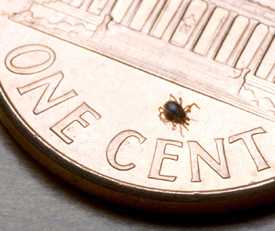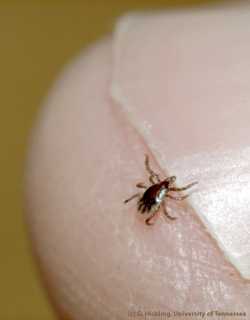Epidemiology & Risk Factors

A nymphal stage Ixodes scapularis tick (about the size of a poppy seed) is shown here on the back of a penny. Credit: G. Hickling, University of Tennessee.
People can get infected with Babesia parasites in several ways:
- The main way is through the bite of an infected tick—during outdoor activities in areas where babesiosis is found (see below).
- A less common way is by getting a transfusion from a blood donor who has a Babesia infection but does not have any symptoms. (No tests have been licensed yet for screening blood donors for Babesia.)
- Rare cases of congenital transmission—from an infected mother to her baby (during pregnancy or delivery)—have been reported.
Babesia parasites are not transmitted from person-to-person like the flu or the common cold.
Many different species (types) of Babesia parasites have been found in animals, only a few of which have been found in people. Babesia microti—which usually infects white-footed mice and other small mammals—is the main species that has been found in people in the United States. Occasional (sporadic) cases of babesiosis caused by other Babesia species have been detected.

Typically B. microti is transmitted by the nymphal stage of Ixodes scapularis ticks (about the size of a poppy seed). Credit: G. Hickling, University of Tennessee.
Babesia microti is transmitted in nature by Ixodes scapularis ticks (also called blacklegged ticks or deer ticks).
- Tickborne transmission primarily occurs in the Northeast and upper Midwest, especially in parts of New England, New York state, New Jersey, Wisconsin, and Minnesota.
- The parasite typically is spread by the young nymph stage of the tick, which is most apt to be found (seeking or "questing" for a blood meal) during warm months (spring and summer), in areas with woods, brush, or grass.
- Infected people might not recall a tick bite because I. scapularis nymphs are very small (about the size of a poppy seed).
- Page last reviewed: February 4, 2014
- Page last updated: February 4, 2014
- Content source:


 ShareCompartir
ShareCompartir